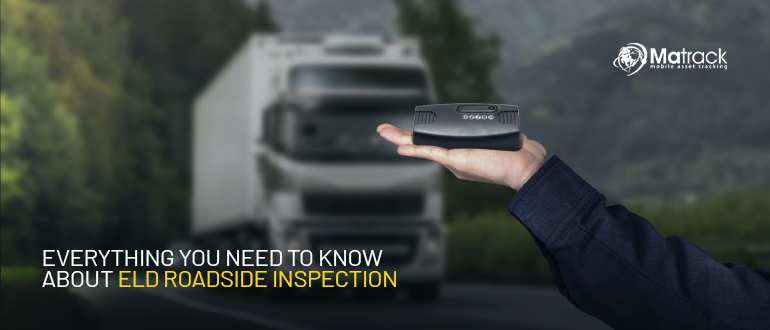Everything You Need To Know About ELD Roadside Inspection
With the ELD mandate, the Federal Motor Carrier Safety Administration has made a recording of data more accurate and easier. Through the electronic logging device, FMCSA can also ensure that the rules of hours of service are being diligently followed by the drivers as well as carriers. As most information that an ELD collects is automatic, the chances of data being manipulated are absolutely impossible.
As the ELD technology is new, it is important for motor carriers to train their drivers, especially when it comes to roadside inspection. According to a report ‘Roadcheck Inspection’ published by Commercial Vehicle Safety Alliance (CVSA) in 2017, a 72-hour inspection raid was conducted, which resulted in service termination for 19.4% commercial vehicles and 4.2% commercial drivers. The major reason for these numbers is probably the lack of awareness amongst motor carriers and drivers about roadside inspection procedures related to ELD.
In order to decrease the number of commercial drivers and commercial vehicles being placed out-of-service and further avoid violations of FMCSA and DOT regulations, Matrack has created this guide to help you understand the roadside inspection procedure. In this guide, we will be comprehensively discussing all the steps involved in the inspection, how to pass them, and the overall benefits of ELD for drivers and motor carriers.
Content
- 8-Levels of Roadside Inspection:
- #4 – North American Standard inspection – Special Roadside Inspection
- #5 – North American Standard inspection – Vehicle only Inspection
- #8 – North American Standard Electronic Inspection
- How ELD can help in envading or avoiding vehicle as well as driver-related violations in roadside inspection?
8-Levels of Roadside Inspection:
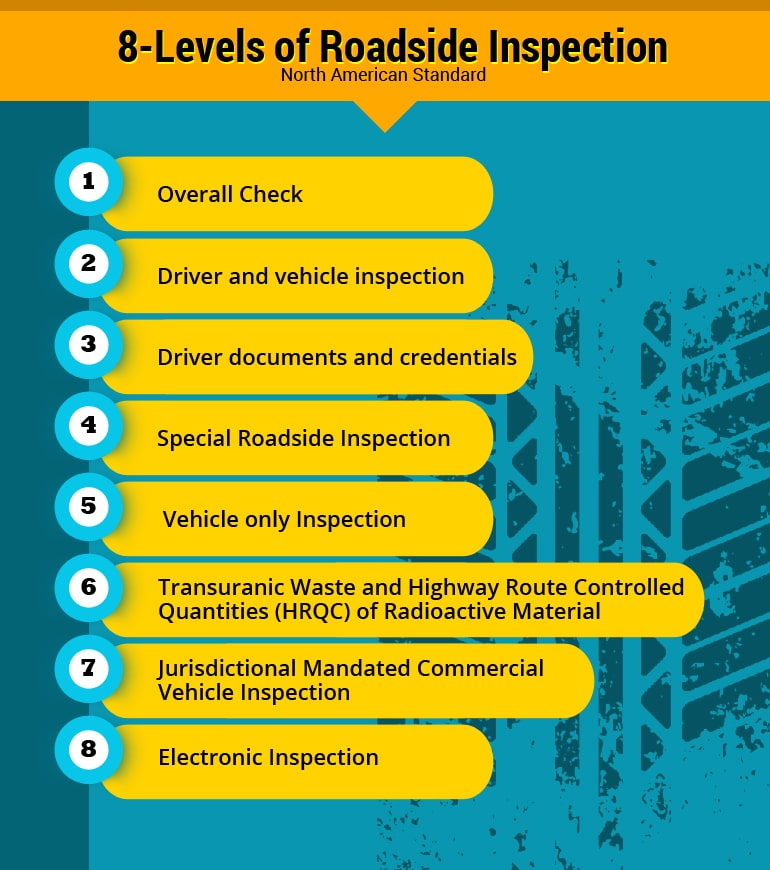
The roadside inspections are conducted by Commercial Vehicle Safety Alliance inspectors. Most commercial drivers and carriers know about 7 different types of roadside inspection. However, there is one new type of inspection – a digital one, which we will be discussing here together with all the others.
All the levels of inspection are not generally conducted in any particular order. A few of these are quite lengthy, while others not so much. However all the levels or types are equally important, and therefore a thorough knowledge of each will help commercial drivers and motor carriers in avoiding violations and penalties.
#1 – North American Standard Inspection – Overall Check
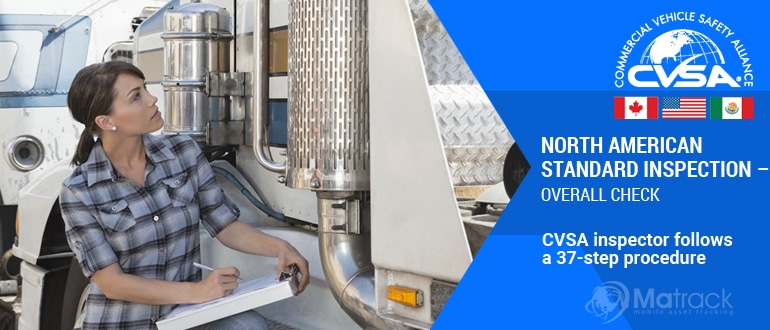
The roadside North American Standard Inspection is one of the most comprehensive ones of all inspection levels.
The CVSA inspector follows a 37-step procedure under this level to thoroughly review the commercial driver as well as the vehicle. Here are the steps involved:
- The inspector chooses a site for inspection
- Then the inspector will approach the vehicle
- The inspector will greet the driver and prepare him/her for the inspection
- The first step of the inspection is to interview the driver
- Collect the driver’s documents
- Check the vehicle for the presence of any hazardous or dangerous material and goods
- Identification of the carrier
- Check Driver’s license or/and CDL
- Examine Medical Examiner’s Certificate and Skill Performance Evaluation Certification (if required)
- Checks RODS (Records of Duty Status)
- Examine Driver’s Daily Vehicle Inspection Report (if applicable)
- Check Periodic Inspection Report
- Inform and get the driver prepared for the Vehicle Inspection
- Inspect the front of the tractor
- Inspect Left front side of the tractor
- Inspect Left Saddle Tank Area
- Inspect the front of the trailer
- Inspect Left rear tractor area
- Inspect Left side of the trailer
- Inspect Left Rear trailer wheels
- Inspect rear of the trailer
- Inspect Double, triple and full trailers
- Inspect Right Rear trailer wheels
- Inspect right side of the trailer
- Inspect Right rear tractor area
- Inspect right saddle tank area
- Inspect right front side of the tractor
- Inspect Steering Axle(s)
- Inspect Axle(s) 2 and/or 3
- Inspect Axle(s) 4 and/or 5
- Prepare the vehicle and check brake adjustments
- Inspect tractor protection system
- Inspect brake system warning devices
- Test Air loss Rate
- Check Steering Wheel Lash
- Check the Fifth Wheel Movement
- Complete the Inspection
Apart from the above-mentioned steps, the inspector might check for other things like seatbelt usage, prohibited drug or alcohol usage by the driver, hours of compliance, and any other safety regulations.
#2 – North American Standard inspection – Driver and vehicle inspection
This is level 2 of the inspection, wherein the safety officer generally walks around the vehicle or talks to the driver to inspect the following:
- Commercial Driver’s License
- Medical examiner’s certificate
- Skill Performance Evaluation (SPE) certificate, if required
- Alcohol and Drug test
- Seatbelt
- Driver’s Hours of Service (HOS)
- Driver’s Record of Duty Status (RODS)
- Brake System
- Windshield Wipers
- Suspension
- Tires
- Rims and Hubs
- Exhaust System
- Coupling Devices
- Driveshaft
- Wheels
- Van and open-top trailer
- Headlamps, tail lamps, turn signals, stop lamps, and other lighting devices
- Fuel Systems
- Frames
- Cargo Securement
- Steering mechanisms
Level 2 of the roadside inspection essentially requires the safety inspector to do a thorough check of the above, without having to go under the vehicle. During this level of inspection, the safety officer tries to do a closer examination of the vehicle/driver.
#3 – North American Standard inspection – Driver documents and credentials
Under the level 3 of the North American Standard Inspection, there are certain driver documents and credentials listed. The safety inspector is required to examine these credentials. It is important to note that if a document is not listed under this inspection, it cannot be considered to be examined as a Level 3 inspection.
As applicable or required, the safety inspector examines the following:
- CDL or commercial driver’s license
- Certificate by the Medical Examiner (if applicable)
- Skill Performance Evaluation Certificate (if applicable)
- Driver’s Record of Duty Status (RODS)
- Hours of Service
- Seatbelt Usage
- Vehicle Inspection Report (if Applicable)
#4 – North American Standard inspection – Special Roadside Inspection
After having done all the examinations in the level 1, 2, and 3, if the safety inspector does a special one-time inspection in the following cases:
- Earlier inspections have risen a doubt about any particular vehicle part or any driver documentation
- To rule out any particular discrepancy or chances of regulation violation
Level 4 of the roadside inspection is different from earlier levels, as it requires a re-check or re-examination to either confirm or deny the possibility of an inconsistency. It does involve checking the entire vehicle or conducting another driver inspection.
#5 – North American Standard inspection – Vehicle only Inspection
Level 5 of the roadside inspection involves all the inspections as listed under level 1. The only difference between the two is that for level 5 inspection, the driver is not required to be physically present. Also, the inspection can take place at any location, as decided by the safety officer.
#6 – North American Standard inspection – Transuranic Waste and Highway Route Controlled Quantities (HRQC) of Radioactive Material
This level of inspection is done to ensure that any commercial motor vehicle transporting radioactive material follows the specified regulation for storage and quantity of the same. Unless a commercial motor vehicle is carrying spent-fuel, high-level radioactive waste or any other transuranic waste, it is not required to be subjected to level 6 of roadside inspection.
#7 – Jurisdictional Mandated Commercial Vehicle Inspection
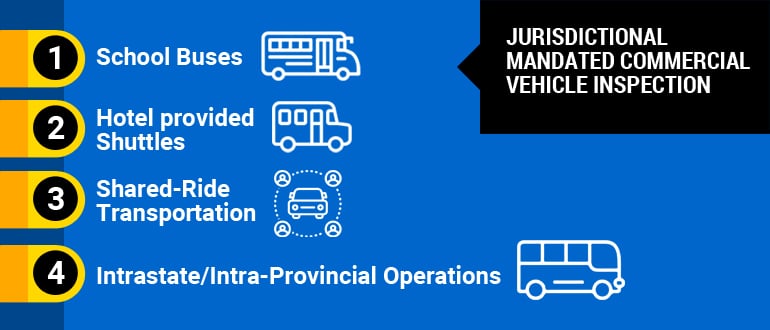
The jurisdictional mandated commercial vehicle inspection applies to the following:
- School buses
- Hotel provided shuttles
- Shared-ride transportation
- Intrastate/intra-provincial operations
Under this level, a CVSA safety officer can inspect any vehicle falling under the above-mentioned criteria, even if other levels of inspections are not applicable to the said commercial vehicle. Also, apart from CVSA certified inspector, Level 7 inspections can also be conducted by any jurisdiction-approved contractors or designated government employees.
#8 – North American Standard Electronic Inspection
Level 8 of the roadside inspection is a new addition to the list, given the increasing use of digital media by commercial motor vehicles and drivers. One of the most unique features of this inspection is that it is conducted wirelessly or electronically, without direct communication with the safety office. The inspection is conducted while the vehicle is on the move.
The Commercial Vehicle Safety Alliance has listed down certain points for a commercial vehicle to qualify for this inspection, and the following data has to be sent to the safety officer, wirelessly or electronically:
- GPS coordinates, along with a description of the location
- Electronic validation of the vehicle’s operator
- License status
- Driver’s license class and endorsement for the vehicle being operated
- Skill Performance Evaluation (SPE) Certification
- Medical Examiner’s Certificate
- Records of Duty Status (RODS) of current driver
- Hours of Service Compliance
- USDOT number
- Power Unit Registration
- Operating Authority
- Unified Carrier Registration compliance
- Federal out-of-service orders (If any)
Several separate authorities and research groups have conducted various studies to analyze the kind of violations that are common to be found during a roadside inspection. The information provided through these studies can prove to be helpful for commercial drivers and carriers in avoiding violations and penalties.
- Level 1 is the most common Inspections: As level 1 of the roadside inspection involves a very comprehensive examination of the vehicle and the driver, it is more favored by the safety officers. Also, the type of cargo a vehicle is carrying is also determined how frequently it will get inspected. According to researchers, vehicles engaged in drive-away/tow-away operations and vehicles carrying fresh produce are more likely to be stopped for Level 1 inspection. While on the other hand, vehicles carrying livestock or coal/coke are less likely to be stopped for an inspection. Based on the type of cargo you are carrying, it is best to be prepared for a roadside inspection.
- Common Violations: Most common violations as found during inspections are the ones related to the vehicle. Some of the major violations were:
- All mandatory lamps should be capable of being operated at all times
- Parts and accessories must be in safe and proper operating condition at all times.
- Every commercial motor vehicle must be operated in accordance with the laws, ordinances, and regulations of the jurisdiction in which it is being operated.
- The motor vehicle should be free of oil and grease leaks.
- The pushrod stroke must not be greater than the values specified.
Next time you head to the road, make sure that you are operating in permitted area, and all your vehicle parts are in working condition.
- State-wise HOS violations: Various states in the US have stricter rules and regulations when it comes to Hours of Service. Independent researchers have indicated that states of Connecticut, Idaho, and Louisiana are stricter, have a very high (above 80%) rate of HOS violations. Similarly, the states of Mississippi, South Dakota, and Massachusetts have a comparatively lower rate (about 30%) of HOS violations. Therefore, before you drive interstate, it is best to read up on various regulations and norms followed by the states you will be traveling in order to avoid violations.
How ELD can help in envading or avoiding vehicle as well as driver-related violations in roadside inspection?
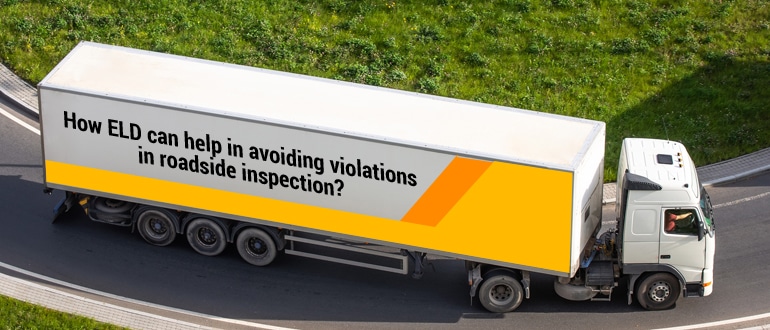
The Commercial Vehicle Safety Alliance conducted a 72-hour long roadside inspection, with a major focus on cargo securement. During this period, a total of 40,994 inspections were held, resulting in 19.4 % commercial motor vehicles and 4.7% drivers being placed ‘out-of-service’ in relation to various violations. The majority of inspections conducted were Level 1, 2 and 3. One of the common reason for vehicle-related violation were connected to brake systems, while driver-related violations were connected to HOS data.
The major two violations – brake system and Hours of service – could have been easily avoided through the help of the Electronic Logging System (ELD). As you already know, the ELD mandate was brought into effect to make a recording of HOS data more accurate. ELDs record Hours of Service data automatically, and also prompts the driver and operator in case there is a chance of violation in the future, thereby allowing them to take necessary steps and avoid the same.
Most ELDs these days come equipped with vehicle diagnostics. It helps in alerting the driver and carrier if the vehicle or any part of it requires repair or restoration. This feature will definitely help in maintaining the brake system of the vehicle, thus helping in avoid related violations. Through vehicle diagnostic reports provided by the electronic logging device, motor carriers and drivers can ensure that the vehicle is in good health, and plan a better maintenance schedule for the same.
Another violation that has reduced drastically after the use of ELDs is the Form and Manner violation, as the ELD automatically records date, time, driver status, duty status, and can also carry forward the information to the next day, for the same vehicle but different drivers. ELD also records driving status and truck stops, as well as prompts the driver to indicate whether the on-duty status stop is for loading or fueling and whether off-duty status is for a break or sleeper berth. This ensures that all changes in driving status and their nature is correctly documented, without leaving a chance for any kind of discrepancies. As the ELD records are authentic and accurate, the chances and number of violations of any FMCSA and DOT regulation are inevitably decreased. This offers the drivers and carriers a huge relief, and allows them to pay more attention to better planning and driving, and improves the overall fleet management.
How to pass the roadside inspection successfully?
To pass a roadside inspection successfully, a driver needs a good understanding of the inspection process as well as proper training and knowledge of his own vehicle and other related systems. Once a driver knows how an ELD works, where he can find all the necessary information, keeps his/her work organized, and follows safe driving rules, he/she does not need to worry about the inspection at all. In short, here are a few things a driver must do to avoid violations in an inspection:
- Keep all required documents organized and updated
- Know the type of cargo you are carrying and any rules related to the same
- Maintain the vehicle periodically
- Repair and replace any faulty part of the vehicle
- Avoid the intake of alcohol and drugs during duty hours
- Understand the driving window and driving time, break and sleeper time
- Plan your route to make the best of your driving time
- Follow Hours of Service rules
- Drive safely.
As per the ELD mandate, the last day to switch to the new technology is December 16th 2019. If you haven’t made the switch yet, now is a good time. ELDs are upgraded versions of the old ABORD, and require proper training to use them effectively. ELD Compliant together with FMSs, can be very beneficial for your business.
Matrack Incorporation has a comprehensive, easy-to-use and advanced ELD and Fleet management system, which can help you in streamlining your business and make the most of your available resources. We created this guide to help you with using ELDs during a roadside inspection. We have been serving the industry with compatible, convenient and effective solutions for over a decade. We assure you the best customer service, at a very competitive rate. If you need more information on ELDs and Fleet management services, feel free to contact us.
